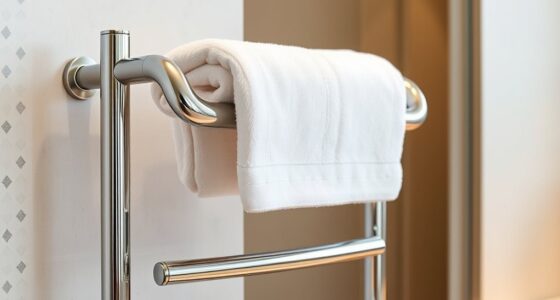I’ve often wondered if it’s safe to flush lint down the toilet.
In this article, we’ll explore the composition of lint and its potential impact on our plumbing systems.
We’ll also discuss the consequences of flushing lint and provide alternative methods for disposing of it.
Additionally, I’ll share some tips for reducing lint accumulation in your laundry.

By the end, you’ll have a clear understanding of whether or not flushing lint down the toilet is a good idea.
Key Takeaways
- Flushing lint can lead to water pollution and harm aquatic life.
- The accumulation of lint in plumbing systems can result in costly repairs.
- Disposing of lint in the trash or recycling is the best way to mitigate the environmental impact.
- Alternative methods for disposing of lint include composting, using it as a firestarter, or as pet bedding.
The Composition of Lint and Its Potential Impact
Lint is composed of tiny fibers that come from fabrics and can cause clogs and blockages in plumbing systems when flushed down the toilet. These fibers are primarily made up of natural materials like cotton and wool, but can also contain synthetic fibers such as polyester and nylon. The composition of lint can vary depending on the type of fabric it originates from.
When lint is flushed down the toilet, it can have a negative impact on the environment. The fibers from lint can escape wastewater treatment plants and enter rivers, lakes, and oceans. This can lead to water pollution and harm aquatic life. Additionally, the accumulation of lint in plumbing systems can result in costly repairs and maintenance.
To mitigate the environmental impact of lint, it’s recommended to dispose of it properly by throwing it in the trash or recycling it if possible. Regular cleaning of lint traps in dryers can also prevent excessive lint buildup and reduce the chances of it ending up in the plumbing system.

The Consequences of Flushing Lint Down the Toilet
Flushing lint down the toilet can result in clogs and blockages, causing potential damage to plumbing systems. When lint is flushed, it can accumulate in the pipes and create obstructions, leading to sewage system issues.
As lint is composed of fibers that don’t break down easily, it can build up over time, reducing the flow of water and causing backups. These clogs can be costly to fix, requiring professional assistance and potentially causing extensive damage to the plumbing infrastructure.
Moreover, flushing lint down the toilet can have an environmental impact. When the sewage system becomes blocked, untreated wastewater may overflow into natural bodies of water, polluting the environment and harming aquatic life.
To prevent these consequences, it’s best to dispose of lint properly by throwing it in the trash.

Alternative Methods for Disposing of Lint
One effective way to dispose of lint is by throwing it in the trash. However, there are other options for those who want to reduce waste and find creative uses for lint. Recycling is a great alternative to throwing lint away. Some recycling centers accept lint, especially if it is made of natural fibers like cotton or wool. Check with your local recycling facility to see if they accept lint and how it should be prepared for recycling. Another option is to repurpose lint for various purposes. Here are some creative uses for lint:
| Creative Uses for Lint | |
|---|---|
| 1. Composting | Use lint as composting material to enrich the soil in your garden. It helps retain moisture and adds nutrients to the soil. |
| 2. Firestarter | Lint is highly flammable and can be used as a firestarter for campfires or fireplaces. Place it in a cardboard egg carton, add some wax, and light it up. |
| 3. Pet Bedding | Line your pet’s bed with lint for extra warmth and comfort. Make sure to use lint that is free from any harmful chemicals or contaminants. |
Tips for Reducing Lint Accumulation in Your Laundry
To reduce lint accumulation in your laundry, I always make sure to clean the lint filter before each load. This is an essential step in preventing lint buildup and ensuring that your clothes come out clean and lint-free.
In addition to regularly cleaning the lint filter, there are other effective lint removal methods you can utilize. One method is to separate lint-prone items, such as towels or fuzzy sweaters, from other clothing items. This helps to minimize the transfer of lint during the washing and drying process.
Another effective technique is to use dryer balls or clean tennis balls in the dryer. These balls help to agitate the clothing and dislodge any lint, resulting in cleaner clothes.

Conclusion: the Final Verdict on Flushing Lint Down the Toilet
After considering the potential consequences, I have come to a clear conclusion regarding whether or not lint can be flushed down the toilet. Flushing lint down the toilet is not recommended due to its negative environmental impact and the potential clogging issues it may cause. Let’s take a closer look at these factors in the table below:
| Environmental Impact of Flushing Lint | Potential Clogging Issues with Flushing Lint |
|---|---|
| Lint contains microfibers that can contribute to water pollution and harm aquatic life. | Lint has the potential to accumulate in pipes and cause blockages, leading to costly repairs. |
| Flushing lint can increase the workload on wastewater treatment plants. | Lint may combine with other materials in the plumbing system, exacerbating clogging issues. |
| Proper disposal of lint, such as throwing it in the trash, is a more environmentally friendly option. | Regular cleaning of lint traps in washing machines can help prevent lint from clogging the plumbing. |
Frequently Asked Questions
Can Lint From Different Types of Fabrics Have Different Compositions?
Different types of fabric can have different compositions, resulting in variations in lint. The composition of lint is determined by the fibers of the fabric it comes from, which can vary in structure and material.
How Long Does It Take for Lint to Decompose in Water?
The decomposition rate of lint in different water temperatures varies. It can take weeks to months for lint to fully decompose. Accumulation of lint in aquatic ecosystems can have detrimental effects on water quality and marine life.
Are There Any Potential Blockages in the Plumbing System Caused by Flushing Lint?
There may be potential health risks and an impact on water quality if lint is flushed down the toilet. It is important to consider the potential blockages in the plumbing system that can occur.

Can Lint Accumulate in Septic Tanks?
Lint can accumulate in septic tanks, potentially causing clogs and blockages. Proper disposal of lint involves throwing it in the trash or using a lint trap to prevent it from entering the plumbing system.
Are There Any Environmentally Friendly Alternatives for Disposing of Lint?
There are environmentally friendly alternatives for disposing of lint, such as composting options or repurposing ideas. These methods can help reduce waste and give new life to lint.
Conclusion
In conclusion, while it may seem convenient to flush lint down the toilet, it isn’t the best method of disposal. The composition of lint can cause clogs in plumbing systems and contribute to environmental pollution.
Instead, consider alternative methods such as composting or throwing it in the trash. Additionally, taking steps to reduce lint accumulation in your laundry, such as cleaning the lint trap regularly, can help minimize the need for disposal altogether.











